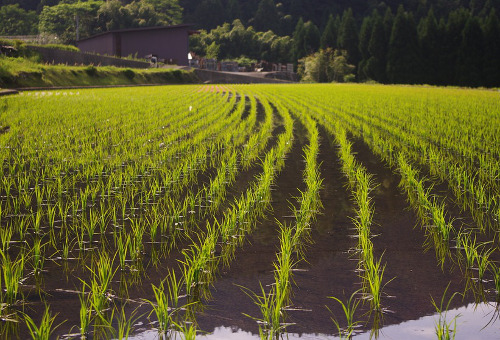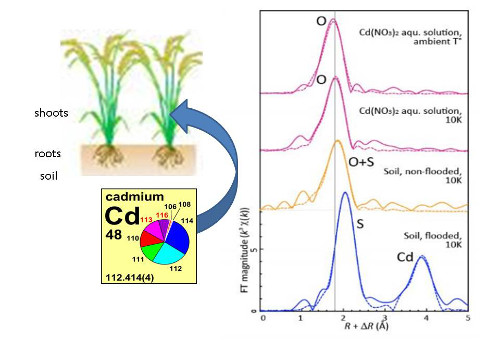

Left: rice crops. Right: Fourier Transforms for two soils in wet and flooded conditions and for cadmium nitrate.
Cerdanyola del Vallès, 9th February 2021 Cadmium is a harmful element due to its toxicity and long half-life time in human bodies. It is an extremely toxic industrial and environmental pollutant classified as a human carcinogen. Cereals are indeed the major sources of cadmium for humans and, in particular, rice, a staple food in several Asian countries, is a particularly high source of this heavy metal.
To reduce cadmium concentrations in rice, the mechanisms that determine its availability from soil to plants, its plant uptake and its transport processes need to be well understood. The present study, resulting from a scientific collaboration involving young researchers among international institutions and large scale facilities between France, Switzerland, Italy, Spain and Japan (the University of Grenoble Alpes, the ETH Zurich institute, the Okayama University, the Ente italiano Nazionale Risi and the ALBA and Soleil synchrotrons), aims to enlighten these mechanisms.
Cadmium usually binds to sulfur, getting immobilized, and the bindings with sulfur is the major driving force for cadmium isotope fractionation (when the isotopic composition of an element of a given compound changes by the transition of that compound from one physical state or chemical composition to another).
The results of this research show how soil flooding in the rice crops not only changed the cadmium speciation in the solid soils but also in soil-aqueous solutions, while vacuolar transport includes the dissociation of heavy cadmium isotopes from a sulfur donor atoms prior to membrane transport and storage in the vacuole. All these findings allow a better tracing of contaminant elements in the complex soil-plant system and permit to asset about final product toxicity when those plants are source of human food.
Synchrotron light techniques to tracing pollutants
To achieve the presented results, the authors combine complementary experimental techniques (like X-rays absorption spectroscopy and isotopic mass detection) in order to prove the selectivity of light/heavy cadmium ions in the sulfur binding process, which determines the different strength of bounds and the different transport mechanisms of the pollutant through the rice plant.
The researchers grew rice (Oryza sativa L.) with functional and non-functional OsHMA vacuolar transporters (an enzyme that plays a major role in the hyperaccumulation of cadmium by the rice plant) in pots under flooded and non-flooded soil conditions. Soil, root and shoot of each treatment were sampled and analyzed. The soil solutions and roots became richer in heavy cadmium isotopes when compared to the roots and shoots, since sulfur organic groups (largely contained in the solution soil) acted as a major trap for cadmium atoms, impeding their transport through the plants. Light isotopes were mainly identified in roots and shoots.
XAS spectra (X-rays absorption spectroscopy) were treated by linear combination fits of well characterized standards. XAS investigations performed at CLAESS beamline at ALBA and at the French synchrotron Soleil have revealed that in soils and in roots cadmium is mainly bounded to sulfur (cadmium sulfides). Soil flooding induces precipitation of cadmium sulfides and enriched the rice in heavy isotopes. Cadmium-oxygen complexes as well as other cadmium2+ hydrated species are instead detected in the shoots.
Beyond the showcase presented, the obtained results provide a blueprint to exploit traceability of pollutants in soils and plants and opened to further advance in the use of light/heavy isotopes to understand the processes controlling the mobility of cadmium in the environment.
Reference: Matthias Wiggenhauser, Anne-Marie Aucour, Sarah Bureau, Sylvain Campillo, Philippe Telouk, Marco Romani, Jian Feng Ma, Gautier Landrot, Géraldine Sarret. Cadmium transfer in contaminated soil-rice systems: Insights from solid-state speciation analysis and stable isotope fractionation. Environmental Pollution 269 (2021) 115934. DOI: https://doi.org/10.1016/j.envpol.2020.115934




